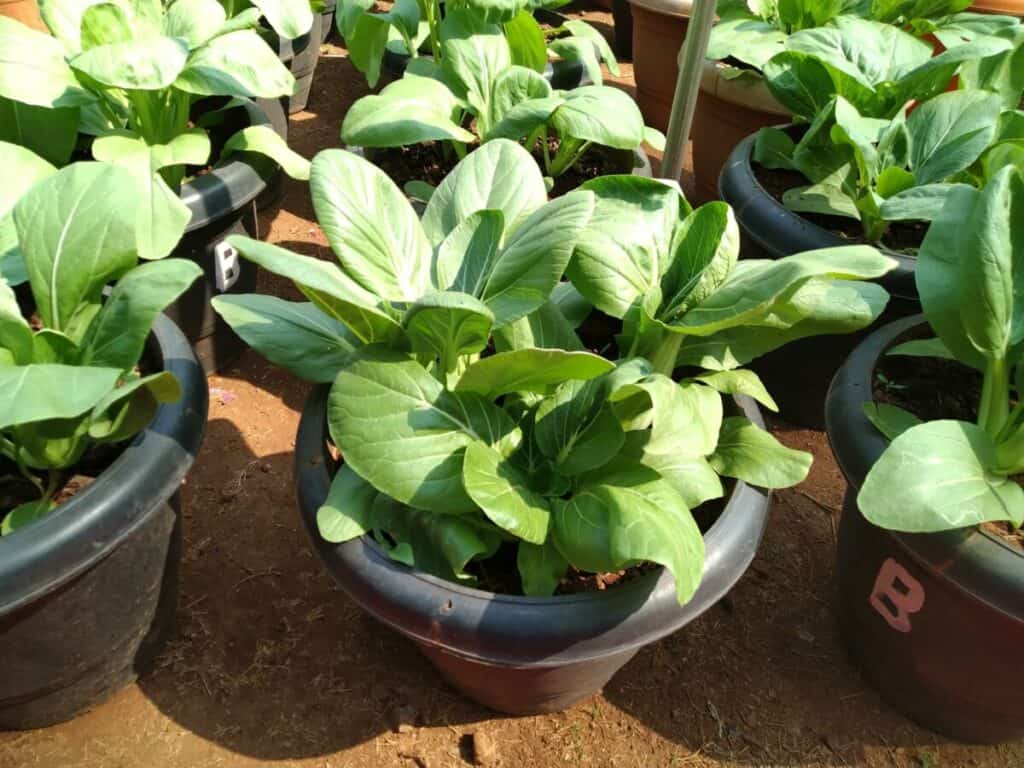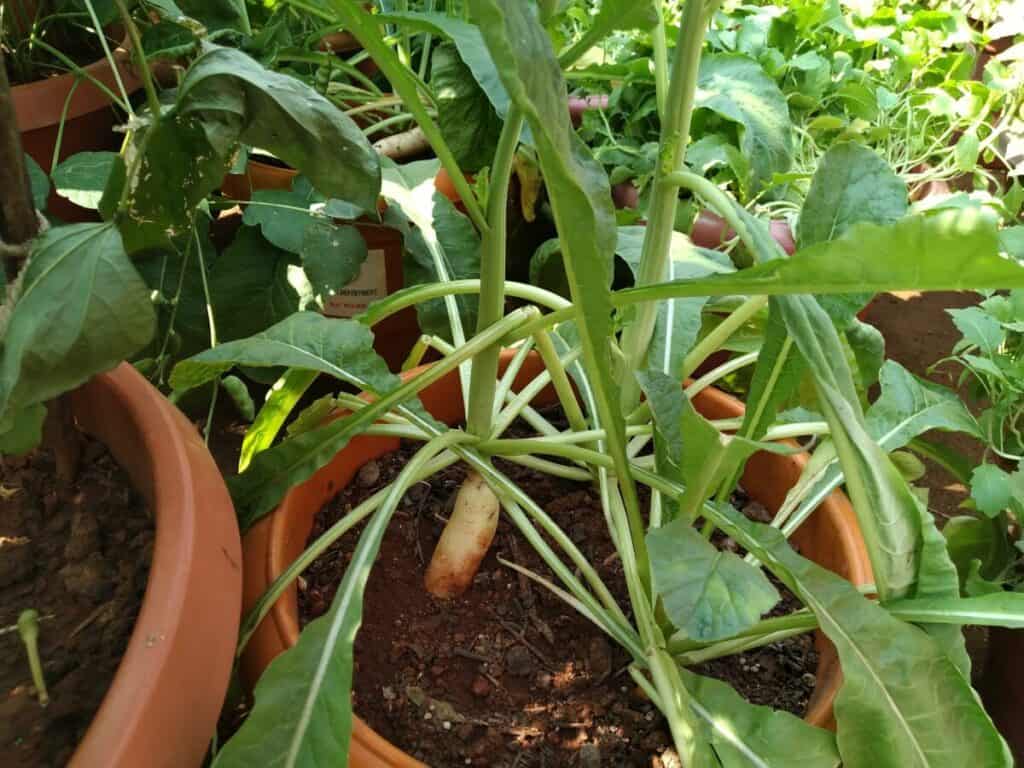You don’t need acres of land to grow your own vegetables. Earlier in my gardening ventures, I had limited usable space. So, I did some research to figure out how to grow a rooftop vegetable garden. You can find the results of my research below.
What Layout Can I Use for the Rooftop Garden?
Rooftop gardens are more popular than ever. Some urban cities across the world are even requiring property developers to dedicate some roof space for plants.
Whether you live in a crowded city or simply want to utilize unused space for greenery, you have a few different options available to you.
Creating a Vegetable Garden in a Pot
If you’re just getting started, your best bet would be to use pots. Tons of vegetable crops can thrive in the confined space of pots. Sometimes referred to as container gardening, this type of layout offers many benefits.
For one, pots are completely mobile. The containers house the soil, the plant’s roots, and any growth. If you need to move things around, it’s as simple as picking up the pot and lugging it to its new home.
This is perfect for your rooftop. You can create a layout that works for you and adapt the design as your plants grow.
The second benefit is that potted plants are easier to maintain. Weeds can still infiltrate the soil, but the chances of that happening are much slimmer. Most pots have a relatively small surface soil area, which will stunt the growth of weeds.
Finally, planting in pots lets you control invasive plants. Some crops like to spread and take over the entire garden. When they’re planted in manageable pots, you don’t have to worry about that.
Create Raised Beds on a Terrace
If you want to create even more usable planting space, you can create raised beds. Raised beds mimic the conditions of the earth. However, the soil sits on top of the roof.
They offer more growing space than pots. Depending on the size of the bed, you may be able to plant several crops together.
Raised beds have great drainage and can help plants thrive. Plus, the layout options are endless. Create several large beds to cover your rooftop garden. Or, use them to create smaller defined gardening spaces. The choice is yours.
Generally, garden beds contain several inches of soil. Between 8 and 12 inches is adequate for most crops, but you can easily alter the design to serve plants that need a bit more room.
Creating a Vegetable Garden in Planters
The terms “planters” and “pots” are often used interchangeably. However, they are two totally different things.
Pots are small and hold a single plant. Meanwhile, planters are large outdoor-only containers that can hold many plants. Generally, they’re in irregular shapes and have unique designs.
Think of planters as the middle point between raised garden beds and pots.
Planters can accommodate multiple plants. Or, you can use them to hold a single large plant. Bigger planters have no problem supporting small fruit trees.
Building a Green Roof
Your last option is a full green roof. This method of rooftop planting is usually out of the scope of most gardeners. It requires careful structural engineering to support.
You could make use of a construction estimating software to find out the cost estimates for building such a green roof.
Green roofs usually have a few inches of soil that cover the entire roof. Basically, you’re creating an enormous garden bed that you can walk on. If you’re lucky enough to get one, you can plant your vegetables directly into the soil like you would a backyard garden.
What are the Things to Consider for a Rooftop Garden?
Ready to start your rooftop vegetable garden? Pump the brakes a bit. There are a few things you need to consider first.
Safety is of the utmost importance. You also have to make sure that your plants are getting everything they need. Here are some things to keep in mind before you start your garden.
Site Considerations
The very first thing to think about if the site itself. If you own your home, half of the work is already done for you. But if you live in an apartment or condo that’s owned by another corporation, things can be a bit trickier. In those cases, you must get written permission and approval.
Even if you do own your home, there might still be some hurdles to jump through. Building codes and HOA bylaws vary from municipality to municipality. Some are welcoming of rooftop gardens. Others will require permits and special permission.
Don’t start your garden before you get the all-clear from your local government. Otherwise, you run the risk of penalties and fines.
You must also think about your neighbors. Most rooftops are within clear view of neighboring buildings. Plants are a great way to create some privacy, but you need to make sure that your plans don’t encroach upon your neighbors’.
Sun and Heat
Gardens need about 6 to 8 hours of sunlight every day. The needs of specific crops vary, but that’s a good general guideline to follow.
Take a look around your roof. Are there any taller buildings blocking the sun? If so, your plants might suffer.
You must also factor in heat. Ambient temperatures on standard roofs can reach up to 150 degrees Fahrenheit. Some plants are hardier to heat than others. But, most will start to suffer when temperatures go beyond 90 degrees.
Water Supply and Drainage
With constant exposure to sun and wind, your plants are going to need a lot of water. Unless you plan on running gallons of water up and down stairs every day, you’ll want to ensure that your garden has a water supply.
Many urban gardeners use a drip irrigation system from a rooftop spigot. If you don’t have a spigot, you should be able to install one without any issues. Though, this is an added cost to think about.
If that doesn’t work, consider a rain collection system.
Drainage is crucial, too. Make sure that your roof has a drain and gutter system to divert water away from your home. If you’re doing raised beds, you’ll need to create drainage layers.
The most important thing is to make sure that water doesn’t sit on your roof and damage your home.
Wind
In urban environments, the wind is a big problem. The average wind speed is usually higher in cities because of a phenomenon known as “Urban Wind Island.”
To prevent your plants from tumbling onto the sidewalk below, you might want to install some barriers. Check with your local codes to see what height, material, and designs they allow.
Soil
You can’t just use normal dirt on rooftop gardens. Standard soil from the ground will experience compaction, making it impossible for plants to grow.
Instead, you must use a growing medium. This includes nutrient-rich potting soil and other carefully planned materials. Some jurisdictions even have regulations that control the types of growing mediums you can use.
Generally, the soil must be well-aerated, sterile, lightweight, and resistant to decomposition. Check with your local government.
Planters, Containers, and Raised Beds
Next, you’ll want to consider what types of containers you want to use. Refer to the section above to see what’s right for you.
You don’t have to stick with just one type. Mix and match containers to get the look you’re after.
Roof Structure
You can’t stick a garden on any roof.
For one, you have to make sure that it’s safe for you to be on. You cannot create your garden on a sloped roof. Even with a shallow pitch, there’s the risk of falling off. Most local governments won’t even allow it.
You must have a flat roof. Most flat roofs have additional features that can support your gardening endeavors. One example is a built-in drainage system.
But even then, you have to make sure the structure can handle the weight and water of your garden.
Added Weight and Load Capacity
Depending on the design of your garden, it could weigh about 100 pounds per square foot. Not all roofs can support that.
The last thing you want to deal with is structural damage to your home. Hire a structural engineer and ensure that your roof can support the weight of your garden above.
What Kinds of Plants Could I Plant on a Rooftop Garden?
You have a lot of options when it comes to plants.
The best kinds of vegetable plants for rooftop gardens are going to be cultivars with a limited root system. You can sometimes get root-heavy plants, but you’ll need a larger planter to keep everything contained.
Here are a few crops you can try out.
Herbs
Herbs do very well on the roof. Not only are they easy to grow, but most are hardy enough to thrive in tougher environments.
Most herbs have a relatively shallow root system, too. So, you can grow them individually in plants or group them up in raised beds. Herbs even do well on balconies and small terraces.
As long as you provide the essentials, you should have no problem growing herbs in your rooftop garden.
Tomatoes
While most tomatoes cultivars do need a trellis system to thrive, they till do well in rooftop gardens. Put them in a large pot with at least 12 inches of soil. Add a stalk or trellis and you have a beautiful addition to your garden.
If you don’t want to go through the stalking process, you can also go with bush varieties. Bush tomatoes are smaller and don’t require a ton of space.
Leafy Greens

Lettuce, cabbage spinach, and other leafy greens are great to have in your garden. They provide a healthy source of vitamins and many grow very quickly.
Most importantly, they have a shallow root system. All they need is usually 4 to 6 inches of soil.
Peppers
Whether you like them hot or prefer a sweeter flavor, peppers are a great go-to. Several kinds of peppers do just fine in containers.
Not only that, but the hotter temperatures up there can benefit the growth cycle. Try out some bell peppers, jalapenos, and chili peppers.

Root Vegetables
Believe it or not, root vegetables are a good choice for rooftop gardens. Root vegetables like carrots, radishes, and beats do well in containers.
You will need a deeper container. But, these plants don’t require a ton of horizontal space, which is great for rooftop gardening.

How to Maintain Your Rooftop Garden
Once you have your rooftop garden up and running, your work will continue. Like any ground-based garden, it takes a lot to keep these unique gardens in good shape.
Monitor Moisture Levels
Rooftop gardens have all the factors to dry out your garden. They’re hot, have a lot of sun exposure, and tons of exposure to the wind. Those conditions can quickly ruin the soil.
You need to water your plants regularly to keep them well-hydrated.
An irrigation system might be worth looking into. If you have a particularly large garden, they can take out a lot of the guesswork.
Drip irrigation systems are very common. They water your plants slowly throughout the day without causing waterlog issues.
Another option is a sprinkler system. Like sprinklers on the ground, you can set them up to provide a light mist at appropriate times throughout the day.
On the other side of the coin, you might live in an area with frequent rain. If that’s the case, you want to limit watering your plants.
Heavy rains will saturate the soil, making it extremely heavy. You don’t want to add any more weight to the equation.
Keep an eye on moisture levels and make adjustments as needed.
Keep the Drain Clear
Standing water on your roof is not something you want to deal with. Even if you have a robust concrete roof, ponding is something you want to avoid.
Monitor the drain and avoid placing plants too close. Drains are a moist and humid environment, so plants will easily grow toward them. This clogs the system up and prevents water from escaping the roof efficiently.
Get Rid of Weeds
For the most part, rooftop gardens have fewer problems when it comes to weeds and pests. But, they’re not immune.
The most common way weeds get into rooftop gardens is through birds. They fly overhead and drop a little surprise that contains weed seeds. Squirrels may also make their way up there and burry seeds.
Take some time to eliminate the weeds so that they don’t overtake your garden and strip the soil of valuable nutrients.
How Much Will It Cost to Build a Rooftop Garden?
Costs for building a vegetable garden on the roof vary quite a bit. It all depends on the design and structure of your building.
Simple green roofs generally cost between $30 and $200 a square foot. But, that’s for a covered roof with only a thin layer of soil and some greenery.
If you want a lively garden filled with vegetables, you could end up spending a lot.
Of course, you can manage costs by getting everything done yourself. If your roof is already primed and ready for a garden, you only have to worry about the containers, soil, and seeds.
Where the real costs come in are preparing the structure. Many roofs will require structural reinforcements to support the weight of the soil above. You have to factor in the cost for added support plus fees for your structural engineer as well.
Simple vs. Complex Rooftop Gardens
A simple garden can be cost-effective. These gardens typically utilize standard pots and containers that you can get at any garden store. As long as your roof can handle the weight, there aren’t any major costs to worry about.
Now, complex gardens will cost a pretty penny. Raised beds and full green roofs have multiple layers that you have to install. These include drainage, geotextile, and growing medium. Costs will climb significantly the more complicated your rooftop garden gets.
Keep this in mind when you’re budgeting.

Fact Checked, Written, and Published by Kevin Rodrigues
Kevin is the founder of Gardening Mentor, a website that aims to teach people to grow their own food in a limited space. As a self-taught gardener, Kevin has spent several years growing plants and creating gardening content on the website. He is certified in Home Horticulture and Organic Gardening from Oregon State University. He has a Post Graduate Diploma in Horticulture and Landscape Gardening from Mumbai University.
Read more
